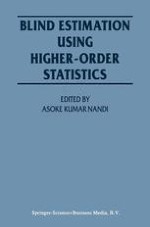1999 | Buch
Über dieses Buch
In the signal-processing research community, a great deal of progress in higher-order statistics (HOS) began in the mid-1980s. These last fifteen years have witnessed a large number of theoretical developments as well as real applications. Blind Estimation Using Higher-Order Statistics focuses on the blind estimation area and records some of the major developments in this field.
Blind Estimation Using Higher-Order Statistics is a welcome addition to the few books on the subject of HOS and is the first major publication devoted to covering blind estimation using HOS. The book provides the reader with an introduction to HOS and goes on to illustrate its use in blind signal equalisation (which has many applications including (mobile) communications), blind system identification, and blind sources separation (a generic problem in signal processing with many applications including radar, sonar and communications). There is also a chapter devoted to robust cumulant estimation, an important problem where HOS results have been encouraging.
Blind Estimation Using Higher-Order Statistics is an invaluable reference for researchers, professionals and graduate students working in signal processing and related areas.
Anzeige
